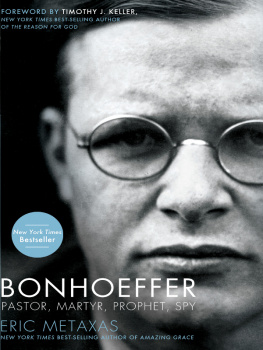The Collected Sermons
of Dietrich Bonhoeffer
_fmt.png)
The Dietrich Bonhoeffer Memorial Church in London was built on the site of Sydenham Church, where Bonhoeffer was pastor from 1933 to 1935. Sydenham Church was destroyed by bombs during World War II.
The Collected Sermons of Dietrich Bonhoeffer

TRANSLATED FROM THE GERMAN BY
Douglas W. Stott
Anne Schmidt-Lange
Isabel Best
Scott A. Moore
Claudia D. Bergmann
Edited by Isabel Best
Fortress Press
Minneapolis
For Sarah and John
and their generation in
Christian ministry
and for those to come
THE COLLECTED SERMONS OF DIETRICH BONHOEFFER
9781451424362
Copyright Fortress Press 2012. All rights reserved. Except for brief quota-tions in critical articles or reviews, no part of this book may be reproduced in any manner without prior written permission from the publisher. Visit www.augsburgfortress.org/copyrights/contact.asp or write to Permissions, Augsburg Fortress, Box 1209, Minneapolis, MN 55440.
New Revised Standard Version (NRSV) translation, copyright 1989 by the Division of Christian Education of the National Council of the Churches of Christ in the USA. Used by permission. All rights reserved.
This book is also available in print at www.fortresspress.com
9780800699048
FOREWORD
D ietrich Bonhoeffer is usually not remembered as a preacher. Although he preached throughout his adult life, there were only two relatively brief periods in which he actually preached every Sunday to a congregation. Both periods were in parishes outside Germany. In 1928, he served as pastoral assistant vicar to the overseas German-speaking congregation in Barcelona, Spain, and then from October 1933 to the spring of 1935 he was the pastor to two German-speaking congregations in London. In addition, he served briefly as a student chaplain in Berlin, and over the years he preached to students, confirmation classes, Sunday schools, and as the occasional guest preacher in churches, and of course he lectured extensively on preaching to his seminarians at the illegal Confessing Church seminary in Finkenwalde from 1935 to 1937. There are seventy-one complete sermons or homilies in the collected worksmore, however, if we include the Bible studies and the circular letters he wrote to his students (many of which are indeed sermon-like; they are certainly reflections on Scripture and how he thought it was speaking to the concerns of his students and the issues of the times).
Bonhoeffer believed that preachingthe proclamation of the word of God as revealed in Scripturewas the very heart of Christian life and worship. But it became something more than that after January 30, 1933. During the Nazi years, Bonhoeffer understood his sermons both as a way of confessing his faith and as a prophetic means to call his church and his students to withstand the ideological spirit of the times. In addition, the act of writing and preaching a sermon became for him a source of spiritual discipline and strengthin fact, I do not think that we can understand Bonhoeffer the resistance figure or Bonhoeffer the theologian without understanding Bonhoeffer the preacher.
Simply in terms of their language and theology, many of Bonhoeffers sermons have a beauty and power of their own. Yet when read in the immediate historical context of when they were preachedwhether in Barcelona in 1928 or Berlin in 1933 or London in early 1935 or in Finkenwalde in 1938they gain an added power and depth, for only then can we begin to understand how Dietrich Bonhoeffer was actively engaging the issues of his times and his church through his preaching.
This volume of sermons selected from the new English translations of the Dietrich Bonhoeffer Works is a significant and long-overdue addition to the literature on Bonhoeffer. Here for the first time is a carefully chosen collection of his sermons, taken from throughout his preaching life, that gives us a full portrait of Bonhoeffer the preacher. Translator Isabel Best, who translated volumes 12 ( Berlin: 1933 ) and 13 ( London: 19331935 ) of the Bonhoeffer Works and contributed to several other volumes, may be considered an expert on the sermons, their nuances and their power. In addition to selecting these sermons, she has provided a helpful introduction to the collection as well as an introduction to each sermon that gives us not only the crucial historical background for each one but also conveys how Bonhoeffers audienceswhether they were diplomats in Barcelona or young seminarians in Finkenwaldewould have heard and understood his words.
Most importantly, she understands how wetodaymight hear these words. This anthology is a powerful illustration of the extent to which these sermons, preached so long ago and in a very different world, nonetheless speak to Christians today. Bonhoeffers writings are remarkable not only because of his poignant life and powerful message under National Socialism but also because he wrote and spoke in a language that has stood the test of time. He had a gift for expressing the very essence of the Christian message and what it means to live the Christian life of faith in this world, and as a result his writings are still read and pondered by Christians around the world and at all points of the theological spectrum.
Nowhere is that clearer than in his sermons. In October 1933, in his very first sermon in London, Bonhoeffer preached on the relationship between pastor and congregation, and he spoke at length about what it meant to preach:
This is what makes a sermon something unique in all the world, so completely different from any other kind of speech. When a preacher opens the Bible and interprets the word of God, a mystery takes place, a miracle: the grace of God, who comes down from heaven into our midst and speaks to us, knocks on our door, asks questions, warns us, puts pressure on us, alarms us, threatens us and makes us joyful again, and free, and certain. When the Holy Scriptures are brought to life in a church, the Holy Spirit comes down from the eternal throne into our hearts, and the busy world outside sees nothing and does not realize at all that God could actually be found here.
God is with us. In the midst of our own busy and very troubled world, this book of the sermons of Dietrich Bonhoeffer will be welcomed by those who seek to understand their own path in our own times.
Victoria J. Barnett
General Editor
Dietrich Bonhoeffer Works, English Edition
EDITOR'S INTRODUCTION
D ietrich Bonhoeffer is considered one of the foremost Protestant theologians of the twentieth century. He was a German Lutheran pastor, best known for his active part in the German Resistance movement that sought to remove Hitler from power during the Second World War. At the time of Bonhoeffers execution by the Nazis in 1945 at the age of only thirty-nine, he was writing groundbreaking theology. He had also been a university teacher, youth leader, church leader, and director of an illegal seminary and other programs to train pastors for the German Protestant Confessing Church under the Nazi regime, and he was active in the international ecumenical movement.
Very close to his heart was the desire to serve his church as pastor of a local congregation. However, he only found time for a year and a half of full-time parish ministry, besides his preparatory year as a pastoral assistant in Barcelona and some months of part-time youth work in churches in Berlin and in Harlem, New York. But the sermons he preached, even as a young pastor and chaplain in his twenties, show how passionately his heart went out to ordinary people and their life struggles and search for meaningful Christian faith. This book is a selection of Bonhoeffers sermons in English translation. The personal faith they reveal was the foundation for all his work.













_fmt.png)
